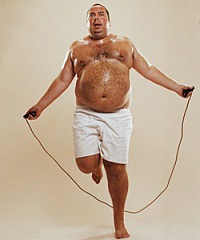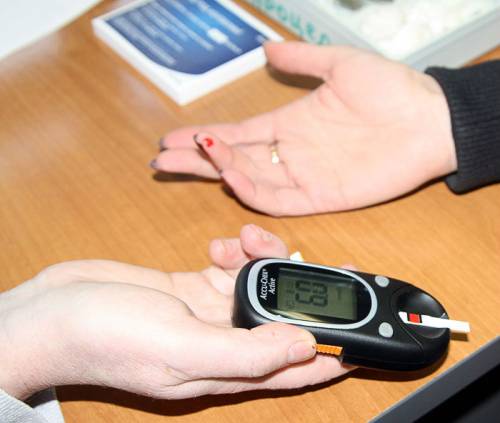Physical exercises at a diabetes mellitus 2. Sports loadings and sensitivity to insulin. The best types of gymnastics for a diabetic
Physical education is a significant part of the treatment of diabetes and many endocrine diseases. Exercise strengthens muscles, normalizes the balance of carbohydrates, fats and proteins.
By combining therapeutic, physical exercises for diabetes, refusal of nicotine and alcohol, you can safely "get out" of the risk group and prevent the development of diabetes.
The mechanisms by which regular physical activity may protect against the development of major vascular disease are under intense investigation. The relationship between the degree of hyperglycemia and the development of large vessel disease is much weaker than for the small vessel and neurological complications of diabetes, indicating the importance of other risk factors. Controversy remains as to whether hyperinsulinemia per se is an important risk factor for atherosclerosis or whether it is a marker of other underlying pathologies.
One of the causes of the disease is malnutrition., which gives rise to . Obesity is the first "swallow", signaling the possible onset of diabetes. As you can see, everything is connected.
Physical activity saves a person from many problems. Sport and physical activity helps to lose extra pounds, which leads to the normalization of metabolic processes.
However, insulin resistance is clearly associated with a group of cardiovascular risk factors independent of hyperglycemia that may contribute to an increased incidence of coronary heart disease. It is important to understand that these risk factors potentiate each other, so that the effect is more than additive when they occur in combination. Additional components of the syndrome include hyperuricemia and, in susceptible women, polycystic ovarian syndrome. Reversal of insulin resistance with regular physical activity is associated with improvement in this entire cluster of cardiovascular risk factors.
But what if you already have diabetes? Is it possible to exercise? First of all, you need to consult a doctor.
There are two forms of diabetes:
(type 1). In type 1 diabetes, insulin is either not produced at all or produced in small quantities.
(type 2). Insulin is produced but not absorbed.
Thus, despite the absence of controlled randomized prospective studies, it is reasonable to encourage physical activity in diabetic patients in the hope of preventing premature coronary disease. Unfortunately, by the time these people present to their doctors, they are often older, sedentary people who may have many complications of their disease. Listed are some of the complications that diabetic patients may experience in exercise programs.
One of the most common is damage. diabetic foot. While vascular diseases contribute to this risk, it is mainly associated with diabetic neuropathy. Reduced pain and pressure sensations result in the use of ill-fitting shoes and a lack of recognition of foot injuries. Denervation and atrophy of the interosseous muscles lead to a change in the shape of the foot and an incorrect distribution of weight. Another important and often overlooked factor is the loss of proprioception. This not only leads to an increased chance of foot injury, but can also contribute to a possible increase in degenerative joint disease.
Type 1 diabetes
Physical exercise in this type of diabetes mellitus is a difficult task. Sugar spikes lead to depression and chronic fatigue. Experiencing pain and, patients avoid physical exertion, move little, which aggravates their condition.
For therapeutic physical therapy (LFK) to be beneficial, patients with type 1 diabetes must pay great attention to self-control and do only the exercises recommended by the doctor.
Careful assessment of blood flow and neurological status of the lower extremities should be part of any assessment of prejudice. Careful attention should be paid to choosing the right footwear. Patients with severe illness may need to limit activities such as jogging in favor of lower forms of exposure. Finally, it should be noted that autonomic dysfunction may put some patients at risk for developing postexperimental orthostatic hypotension, especially on early stage exercise programs when autonomic dysfunction does not appear at rest.
 Physical education in the first type of diabetes brings a lot of trouble. But you can and should exercise in moderation. Regular, vigorous exercise helps the patient begin to feel better.
Physical education in the first type of diabetes brings a lot of trouble. But you can and should exercise in moderation. Regular, vigorous exercise helps the patient begin to feel better.
In some cases, microvascular complications of diabetes may be complicated. Evidence shows that moderately intense exercise does not cause retinopathy and may even have a protective effect. However, in the presence of a serious underlying or proliferative disease, certain types of exercise may predispose the patient to retinal hemorrhage. Direct eye injury can be avoided by wearing safety goggles. Rapid head movements, which can lead to dangerous forces, should be avoided as another potential cause of hemorrhage.
After some time, the diabetic begins to notice that he looks better than his healthy peers, who have abandoned the active lifestyle. It is easier to cope with work and household chores.
It has been noticed that, having become accustomed to self-control, the patient more often measures the level of sugar, in contrast to "lazy" diabetics.

Finally, high-intensity exercises, especially those involving Valsalva maneuvers, should be avoided. In addition to eye disease, there is concern about the potential effects of exercise on the progression of diabetic nephropathy. The degree of proteinuria is approximately proportional to the increase in systolic blood pressure, which occurs during the activity. Using the current criteria for assessing proteinuria, it is important to instruct patients to remain seated for 24 hours prior to collection.
It is not known whether hemodynamic changes leading to proteinuria contribute to the progression of diabetic nephropathy. Exercise the muscles directly underlying insulin injection, may lead to accelerated insulin absorption, which in turn may contribute to hypoglycemia. This occurs primarily with short-acting insulins and only when exercise follows an insulin injection for a short period of time. This can be easily avoided by choosing injection sites away from the muscle training area.
type 2 diabetes
Even more important is exercise in type 2 diabetes. Type 2 diabetes has another unofficial name - obese diabetes. Sport leads to a decrease excess weight, strengthen the body and reduce insulin resistance, that is, it increases the "same" sensitivity to insulin.
Regular exercise for type 2 diabetes is more effective than the best drugs. A simple wellness run significantly reduces the level of insulin resistance.
Under normal conditions, exercise leads to an acute suppression of pancreatic insulin release and a decrease in serum insulin levels. In the presence of an exogenous depot of insulin, normal suppression of insulin levels does not occur, resulting in relative hyperinsulinemia. In addition, some patients with long-term diabetes may develop deficiencies in the release of glucagon and epinephrine, which may also limit their ability to maintain normal level glucose during activity.
Most episodes of significant exercise associated with hypoglycemia occur during or immediately after exercise. In addition to this acute drop in glucose levels, patients should also be aware that after a brisk bout of exercise, delayed bouts of hypoglycemia can occur up to 6-10 hours after surgery and are likely related to changes in insulin sensitivity.
 Diabetic exercise helps to manage a diabetic's condition without insulin injections.
Diabetic exercise helps to manage a diabetic's condition without insulin injections.
The level of insulin sensitivity is directly related to the balance of muscle mass and body fat. The more fat, the lower the sensitivity.
Exercise performed at night can lead to hypoglycemic episodes in the early hours of the morning when the patient is still asleep. In this situation, the absence of insulin's inhibitory effect on hepatic glucose production and lipolysis leads to an overproduction of glucose and keto acids, which can exceed their utilization rate. Poorly controlled patients, especially those who show dehydration, may also show deterioration in glucose control.
Therefore, exercise should be avoided in patients with poor glycemic control. These patients require a thorough pre-exercise evaluation, including a cardiovascular examination, a complete retinal examination after dilatation, and a thorough evaluation of the vascular and neurological status of the feet. Recommendations for stress testing for patients with asymptomatic diabetes remain controversial.
Doctors say that the chance of non-injection regulation of insulin levels with exercise therapy is 90%.
The more muscles, the more the body processes insulin. So, the need for disappears.
exercise for diabetes
Walking in place: Raise your knees in turn and lower your legs, mimicking walking. You can do lunges to the sides, raise your hands up. Breathe voluntarily.
In particular, the need for formal cardiac stress testing with or without imaging is currently under consideration. A wide variety of exercise regimens are available and the flexibility to choose a regimen that suits the patient's lifestyle and takes into account social, financial and medical constraints. Recent studies on a smaller scale show that modest resistance exercise is safe and may also improve glycemic control and cardiovascular risk factors.
The intensity of walking depends on the age and condition of the patient. Walking time is 2-4 minutes.
 Steps
Steps
- Stand up straight, lower your arms.
- Take a step back with your left foot, raising your arms up.
- Raising your hands, take a deep breath.
- Exhale, lower your arms.
- Such exercises for diabetes can be repeated five times.
Squats
In addition, the increase in meat mass resulting from such a program may increase the basal metabolic rate and may be beneficial in maintaining weight. Recent recommendations suggest adding a so-called high-volume exercise component to aerobic exercise recommendations for diabetic patients who have no contraindications. Recent programs have emphasized less formal types of exercise, especially early and behavioral approaches using concepts such as "stages of change" are showing promise in some large studies.
- With straightened arms, make an arc forward and inhale.
- Now make an arc with your hands back and sit down, exhale.
- Stand up, make an arc with your hands forward, raise your hands up, inhale.
- Lower your arms first to your shoulders, then down, exhale.
- Do 6-8 repetitions of the exercise.
Tilt turns
- Put your hands on your waist. Straighten your arms and spread them apart.
- Turn left. The right hand is in front of the chest.
- Now turn to the right so that the left hand is in front of the chest.
- Bend over and reach with your right hand to the toe of your left foot.
- Bend over and reach with your left hand to the toe of your right foot.
- Take your starting position. The number of repetitions is 6-8 times.
A set of exercises for diabetes on the video:
Warm up. Patients should do a short warm-up before stretching. Stretching is important in this population because they may be prone to musculoskeletal injury and should be done smoothly without breathing or jumping motions. Intensity. At practical application a maximum aerobic capacity of ≥ 50% is recommended. Although some epidemiological studies show that less intense exercise may protect against coronary disease, it's clear that acute effect Insulin sensitivity exercise requires at least moderate intensity exercise.
Mahi
- Stretch your hands forward. Make a swing with your left leg, reaching to the palms.
- Make a swing with your right leg, reaching to the palms.
- Do three squats with your arms extended forward and stand up.
- Make an arc with your hands forward, raise your arms up, spread them apart.
- The number of repetitions is 6-8 times.
slopes
Modification of other risk factors may require different levels of exercise intensity. Exercise assignment is usually controlled by heart rate self-diagnosis. The increase in resistance is prescribed as a series of sets of 8-12 repetitions with brief rest periods in between. The degree of resistance should be adjusted so that the patient can perform the exercise without fatigue. Overall, the maximum aerobic exercise capacity of these patients is approximately 15% lower than that of their peers.
However, their aerobic capacity increases with physical fitness. There is some evidence that suggests that two short exercise sessions may be as effective as one longer session, and this approach is often preferred by some patients.
- Put your hands on your waist. Bend over, touch your right hand to the toe of your left foot.
- Bend over again, touch your left foot to the toe of your right foot.
- Make three springy tilts: at the first tilt, reach with your right hand to the toe of your left foot, at the second tilt, reach with your left hand to the toe of your right foot, at the third tilt, reach the toes of both hands with your fingers.
- Straighten up, take the starting position.
- Raise your hands and connect them behind your head, bring your elbows forward, lean back, spread your elbows.
- Straighten up, bring your elbows forward.
- Repeat this set of exercises 4-6 times.

Since much of the regular exercise is due to the overall effect of the individual exercises, it is not possible to replace a reduced frequency with an increased intensity. We strongly recommend that patients exercise at least every day. In a recent New Jersey survey, few physicians discussed increased physical activity with their patients. Perhaps worse, there is little to no effort to encourage more physical activity in people who are known to be at high risk of developing the disease.
Diabetes Type 2 is the most common form of the disease. The treatment of pathology should be comprehensive, that is, in addition to medicines, the patient must follow a low-carbohydrate diet and exercise. Such therapy will help to reduce weight, increase the sensitivity of cells to insulin.
It is important to discuss any of your actions related to physical activity with your doctor beforehand. This is necessary as many exercises are contraindicated in type 2 diabetes mellitus (DM).
It is becoming increasingly clear that a greater focus on increased physical activity will pay dividends in quality of life and lower overall health care costs. Metabolic and genetic characterization of the sequence of pre-diabetic conditions leading to non-insulin dependent diabetes. Diabetes mellitus and macrovascular complications: an epidemiological perspective: excess insulin as the initial lesion in diabetes. Relationships between rates of coronary heart disease and physical activity Physical activity as an indicator of heart attack risk in college graduates Diet and exercise in Oslo: a randomized trial. Biomechanics of the foot in diabetes mellitus. Activity and diabetic vitreous hemorrhages. Urine excretion from albumin during exercise in juvenile diabetes: A provocative test for early abnormalities.
- The role of insulin resistance in human disease.
- Hypertension and the diagnosis of insulin in humans.
Benefits of exercise for diabetes
Physical activity in type 2 diabetes is very important, as it helps to control the course of the disease.
Many people know that people who lead an active lifestyle (exercise daily, run, etc.) age more slowly. With regular training, a diabetic loses weight, looks and feels much better.
Exercise for type 2 diabetes helps regulate blood sugar
Some patients force themselves to study, but usually such attempts do not end in success. In order for training to be regular, you need to choose the right set of exercises and correctly include it in the schedule. Only in this case, the exercises will bring pleasure.
Amateur athletes practically do not get sick, they look younger, healthier, more vigorous. Even at age, they manage to avoid common problems that bother their peers: arterial hypertension, osteoporosis, heart attacks. They do not suffer from senile memory disorders and remain energetic for a long time.
During exercise, the minimum amount of fat is burned (with the exception of daily professional training). With the help of physical education, the patient only controls weight and accelerates weight loss. With regular exercise, a person does not overeat, since a large amount of endorphins (hormones of happiness) are produced in his body. And in the event of hunger, he will eat protein rather than carbohydrate food with great pleasure.
Physical activity in type 2 diabetes
Physical exercise in type 2 diabetes is necessary, as it increases the sensitivity of cells to insulin. Strength training increases muscle mass and reduces insulin resistance (violation of the biological response of body tissues to the action of insulin).

Regular physical activity increases muscle growth, increases the sensitivity of cells to insulin.
Health running and other types of cardio training do not provoke muscle growth, but they also increase the sensitivity of tissues to insulin. If we compare medicines (Siofor or Glucophage) and exercises, then training more effective than drugs 10 times.
The response of body cells to the action of insulin depends on the ratio of fat around the waist to muscle mass. The more fat and less muscle, the weaker the tissues respond to insulin. As muscle mass increases, the required dose of insulin in injections decreases. The lower the concentration of insulin in the blood, the less fat is deposited in the body. After all, this hormone provokes an increase in body weight.
With regular training, after 2-3 months, the cells will become more sensitive to the action of insulin. As a result, it will be easier for the patient to lose weight and control normal blood glucose levels. That is, physical education will help preserve the remaining ß-cells and stop insulin injections.
Useful exercises for diabetics
Physical exercise in type 2 diabetes is divided into strength and cardio training. Strength exercises include weight training (weights, barbells), push-ups, squats, etc. Cardio training helps strengthen the heart and blood vessels, normalize blood pressure, and prevent heart attacks. This group includes running, swimming, cycling, skiing, etc.
![]()
Diabetics are advised to combine strength and cardio training.
Diabetics are encouraged to read the book "Younger Every Year", authored by K. Crowley. It talks about how physical education prolongs life, improves its quality. Its author is already 80 years old, but he leads an active lifestyle (gym, skis, bicycle), is in a beautiful physical form and regularly pleases his fans with new videos.
Diabetics are advised to combine cardio training with strength exercises. A set of exercises for the heart and blood vessels prevents myocardial infarction, saving and prolonging life. And power loads help get rid of joint diseases. That is, one day a diabetic runs or swims, and on the second day he goes to the gym.
When drawing up a training program, the following conditions should be considered:
- The patient fulfills all the restrictions associated with the complication of the disease that have already developed.
- Material waste for sports uniforms and a subscription to the gym should be affordable.
- The place for training should be near the house.
- It is recommended to practice at least every other day, and for pensioners - 6 days a week for half an hour.
- It is important to choose a complex in such a way as to build muscle, increase strength and endurance.
- Begin exercises with a minimum load, which is gradually increased.
- Strength training for one muscle group is not performed for several days in a row.
- It is important to enjoy training, and not work "for show".
Under these conditions, you will learn to enjoy the production of endorphins during training. Only in this case, classes will become regular and bring a real and lasting effect.
The effect of exercise on glucose levels
With regular exercise, insulin will effectively lower the concentration of glucose in the body. As a result, the dose of insulin injections will need to be reduced. If you stop training, this effect will last another 14 days.

Regular and well-chosen exercises lower blood sugar levels
One thing is clear that each exercise affects the concentration of sugar in the blood plasma. Depending on the circumstances, exercise can decrease or increase glucose levels. It is more difficult to control sugar for those patients who are engaged in physical education and use insulin injections for treatment. However, don't give up because of this.
Exercise in type 2 diabetes creates problems for patients who take tablets that stimulate the pancreas to produce insulin. In such cases, it is worth consulting with an endocrinologist about replacing pills with other methods of therapy.
In most cases, glucose levels decrease during exercise, but for this it is important to observe the following conditions:
- Workouts must be long.
- During exercise, you need to control the level of insulin.
- Initially, the concentration of glucose in the blood should not be too high.
Jogging, long walks almost do not increase the amount of sugar in the body.
In type 2 diabetics, moderate to vigorous exercise causes a short-term increase in glucose levels, which over time decreases to normal value. Based on this, it is better for such patients to give preference to long-term endurance exercises.
Rules for preventing hypoglycemia
Hypoglycemia is a condition in which the concentration of glucose drops below 3.3 mmol / l. In patients with type 2 disease, this pathology is prevented during exercise, as the pancreas stops producing insulin.

Carry a glucometer and simple carbohydrates with you at all times to prevent hypoglycemia
To prevent this condition in diabetics with type 2 insulin-dependent disease, the following rules must be observed:
- Charging is contraindicated if the initial sugar is above 13 mmol / l, and for patients who adhere to a low-carbohydrate diet - from 9.5 mmol / l. First you need to lower the concentration of glucose, and then start exercising.
- During physical activity keep a glucometer near you to measure sugar every half hour or hour. If symptoms of hypoglycemia occur, glucose levels are checked immediately.
- Reduce the dosage of long-acting insulin by 30-50%. You can set the exact % reduction in dosage by constantly measuring sugar during and after training.
- Carry simple carbohydrates with you to prevent a severe drop in sugar. The optimal dose is from 36 to 48 g. Doctors recommend having glucose tablets and filtered water with you during classes.
If you are following a low-carbohydrate diet and injecting minimal doses of insulin to control diabetes, then consume no more than 6 g of fast carbohydrates when lowering sugar levels.
Dosage of carbohydrates during training
To prevent sharp decline sugar used simple carbohydrates, preferably in the form of glucose tablets. Many diabetics use fruits or sweets for this purpose, but this is not recommended, since the portion of carbohydrates in them has not been precisely established, and they act later.

Glucose tablets are the most suitable fast carbohydrate for the prevention of a sharp decrease in sugar
That is, to avoid an excessive increase in sugar, it is recommended to take glucose tablets. This drug is used for the emergency elimination of hypoglycemia. Also, for the prevention of this condition, you can use tablets with glucose and ascorbic acid. But first you need to define daily allowance vitamin C, and then look at its content in tablets.
To determine the exact dosage of carbohydrates to compensate for physical activity, you need to measure sugar during training with a glucometer.
About therapeutic effect tablets appear after 3 minutes and persist for 35 minutes. In order to keep the sugar level in the body normal, it is better not to use the entire dose before classes, but to divide it into parts and take it with an interval of 15 minutes. Also, every half an hour, measure the concentration of glucose with a glucometer. If sugar is elevated, then it is better to skip the next dose.
Check sugar before training and taking glucose, if it is below 3.8 mmol / l, then eat carbohydrates. At low sugar it is better to skip the lesson or reduce the load.
The second time the test is carried out 60 minutes after exercise. If the sugar concentration is low, then use glucose. The main thing is to strictly adhere to the dosage. If you cannot calculate the dose of the drug yourself, then consult a doctor.
Special instructions for diabetics
Despite all the advantages of physical education, there are some limitations with type 2 disease. If the patient ignores them, then the likelihood of a complete loss of vision or a heart attack on the simulator increases.
Before starting training, diabetics should consult a doctor!

The doctor will help you choose the right set of exercises for a diabetic
When choosing the type of physical activity, you should pay attention to the following circumstances:
- patient's age;
- the state of the heart and blood vessels (the threat of developing a heart attack);
- physical condition of a person;
- the presence and degree of obesity;
- the length of the disease;
- usual indicators of glucose in blood serum;
- complications of DM.
These factors will help determine the appropriate and categorically contraindicated types of physical education for a diabetic.
With an excessive increase in physical activity, the likelihood of damage to the lower extremities increases. Any injuries on the legs heal slowly and can develop into gangrene, and this threatens with amputation of the foot or limb.
A low-carb diet will help restore nerve conduction in lower limbs. However, this process is quite lengthy, so it is important to be patient.
The effect of sports on the heart and blood vessels
Every diabetic over the age of 30 is highly recommended to have an ECG or exercise electrocardiogram. This is necessary to determine the degree of damage coronary arteries atherosclerotic plaques. The higher the degree of damage, the higher the likelihood that intense physical activity will provoke a heart attack.

Before classes, a diabetic should undergo an electrocardiogram
It is recommended to use a heart rate monitor (heart rate monitor) while exercising. To calculate the maximum heart rate, use the formula - 220 - age. For example, for a 50-year-old patient, the maximum heart rate is 170 beats / min. However, the final decision on the choice of the maximum load is made by the cardiologist.
When you exercise regularly with a heart rate monitor, you will notice that your resting heart rate drops. This means that the heart of a diabetic has become more resilient, then you can think about increasing the maximum heart rate during exercise.
Physical education and hypertension
During exercise, the pressure rises, and this is normal. But if diabetics initially have hypertension and they raise the pressure even more exercise, then it is dangerous. In such cases, the likelihood of a heart attack, stroke, or retinal hemorrhage increases.

If a diabetic high blood pressure, then his condition should be monitored by a doctor
To avoid such complications, follow these recommendations:
- exercise according to how you feel.
- use a heart rate monitor;
- don't try to set a record.
At arterial hypertension you need to choose the right type and intensity of physical activity. The doctor will help you with this.
vision problems in diabetics
Before training, you should consult an eye doctor. This is necessary to assess the degree of diabetic retinopathy, in which the eye vessels become fragile. After excessive physical exertion, bending over or landing abruptly on your feet, the likelihood of rupture of blood vessels in the eyes increases. As a result, bleeding occurs, which can lead to total loss vision.

Before classes, it is necessary to be examined by an ophthalmologist
At high degree retinopathy diabetic is forbidden to perform exercises that require muscle tension or sudden movements with movement. The patient is forbidden to lift weights, do push-ups, run, jump, dive, etc. In such cases, swimming (without diving), moderate cycling, and walking are allowed.
Subject to a low-carbohydrate diet, sugar levels are normalized, eye vessels are strengthened, and the likelihood of hemorrhage is reduced. Then the patient will have access to different types physical education.
Increasing workload in diabetes
With regular training, a diabetic becomes more resilient and stronger. After some time, the usual load will seem too easy, then you need to increase it. Otherwise, you will not develop further, and the physical condition will deteriorate. This rule is the same for any kind of training. When lifting weights, increase the weight after a few weeks. When exercising on an exercise bike, gradually increase the resistance so that the heart muscle is trained. If you're running or swimming, gradually increase your distance or speed.
Thus, physical exercise in diabetes mellitus is an excellent opportunity to lower glucose levels and prevent various complications of diabetes. The main thing is to choose the right set of exercises and gradually increase the load. To avoid dangerous consequences It is recommended to consult a doctor before classes.



















